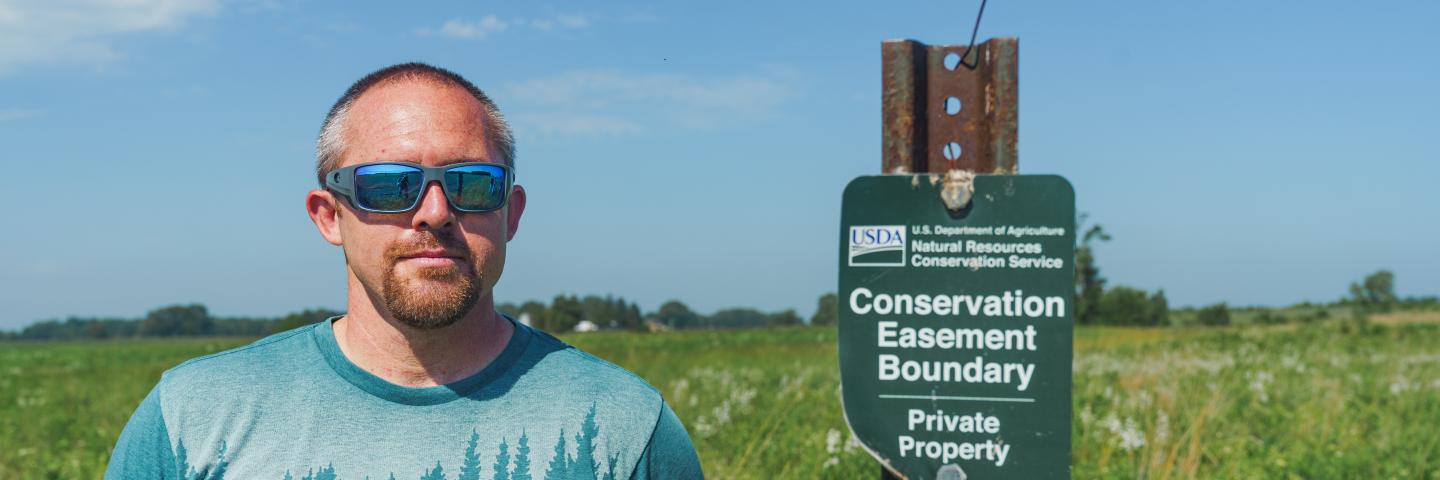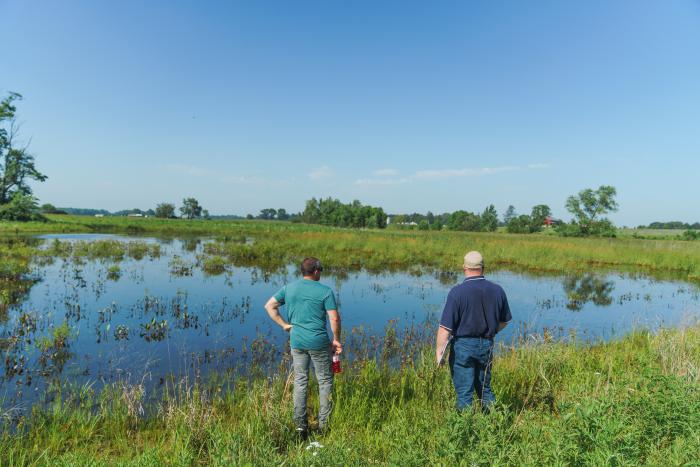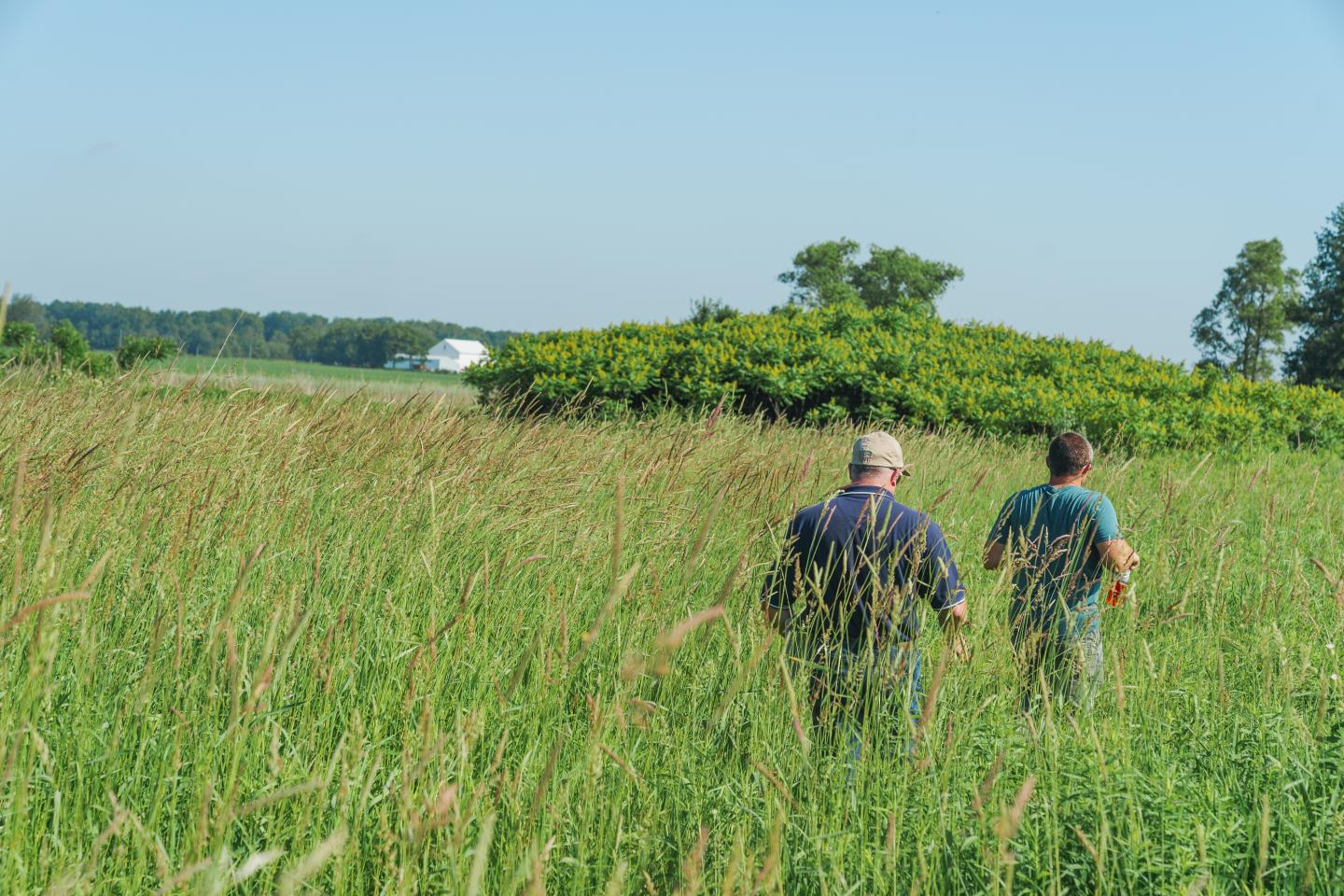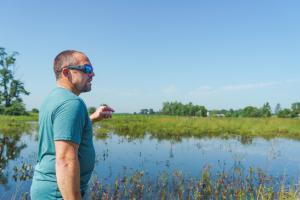Indiana landowner utilizes CRP, WRE to restore cropland into native wetland

John Bellman worked with NRCS and FSA to turn nearly 80 acres of former cropland into a recreational area for his family to enjoy.
By Brandon O'Connor, Public Affairs Specialist, USDA-NRCS, Indianapolis
As the sweltering summer heat inches toward 100 degrees, John Bellman dons his work boots, grabs a cold drink and heads out into the prairie behind his house in Bremen, Indiana.
Knee high grasses and native plants stretch for nearly 80 acres as Bellman leads Troy Manges, a district conservationist with USDA’s Natural Resources Conservation Service (NRCS), and other NRCS representatives on a tour of his property. They start along a mowed grass path that allows easy access to the back of the property before turning left and hiking through the grass to reach a wetland pond that serves as the center piece for the transformed property.

When Bellman purchased the property in 2008 much of the 104 acres was used as cropland and a portion was forestland. While not a farmer himself, Bellman was attracted to the land because of its proximity to Bremen where he had grown up, the ability to turn a portion into a homestead and the potential to create income from the cropland while using the forest recreationally.
He originally rented out the tillable acres to be farmed, but within a couple years he began the process of transforming it into a prairie and wetland to better align with his recreational desires.
Bellman learned of the different opportunities USDA offered for his land through Pheasants Forever. His first step was to enroll 19.5 acres into a 2011 Conservation Reserve Program (CRP) contract, which combines technical assistance from NRCS with financial assistance from the Farm Service Agency (FSA). Through the initial CRP contract, Bellman received an annual payment from FSA to turn the 19.5 acres into field borders planted with native plants to attract wildlife habitat and create travel corridors for game species such as deer and turkey.
As the positive impacts of the field border began to take hold, he started looking toward the future and ways to create additional habitat while also addressing flooding issues caused by a natural wetland located on the property. He settled on enrolling the land in the Wetland Reserve Easement (WRE) component of NRCS’ Agricultural Conservation Easement Program (ACEP). Through WRE, NRCS buys the permanent easement rights to the property, meaning it can never be transformed back into cropland. NRCS covers the cost of restoring the land to its natural wetland state while allowing the landowner to retain his or her ownership of the land and use of it for recreational purposes with some restrictions.
At the time Bellman purchased his property there was a seven-year ownership requirement before he could enroll his land in WRE, so he submitted his application in 2014 and was accepted into the program by NRCS in 2015. While waiting for his application to be accepted, Bellman once again turned to CRP to create additional wildlife habitat. He enrolled about six acres in a CRP contract to create bat habitat through small tree planting throughout the property and 42 acres into a separate contract to create pheasant habitat. When his WRE application was accepted in 2015, the original 19.5 acres of field borders and part of the pheasant habitat was transferred from CRP to WRE to create a roughly 50-50 split with 40 acres in WRE and 40 acres in CRP.

The restoration work on Bellman’s property included the planting of native grasses and other plants to create the prairie, weed control to remove reed canary grass, tree and shrub plantings, and the construction of a wetland pond.
The wetland construction utilized the existing wetland on the former crop field and expanded it to include a total pond area of just over eight acres and a four-acre macro-topography area, which is a shallow pond consisting of different depths that holds water seasonally based on the height of the water table.
The restoration work started in 2016 with construction completed in 2018 and the weed control finalized in 2019.
“The prairie took off really quick, quicker than most. The second year we had native grasses develop seed heads already,” Bellman said. “The trees, you can probably now start really noticing from being just small two or three feet tall bare root seedlings to 10- to 15-foot-tall trees within less than five years. The property is really changing from just an open farm field.”
In the four years since the restoration was completed, Bellman’s property has become a haven for wildlife. As the group, led by Bellman, emerged from the grasses onto the bank of the pond during their tour in June 2022, deer hoof prints dotted the muddy area leading to the water while minnows darted in the shallows and toads croaked in the midday sun.
“It's become almost more of a sanctuary for wildlife,” Bellman said. “There's more emphasis on, you know, the obvious ones like deer and turkey, but there's a lot of non-game species with songbirds and butterflies and things like that, that inhabit the property that normally people don't set out to do, but for me it's a byproduct of the project.”

While the restoration is complete, the property still requires active management. Bellman uses controlled burns to help contain weeds and invasive species while promoting regenerative growth of the desired grasses, pollinator plants and trees. NRCS has also remained a vital resource for him, Bellman said, and he reaches out if he has questions or needs technical assistance on how to manage the property.
Overall, the project would not have been possible without the help of NRCS, Bellman said, including the financial investment the agency made and the technical expertise to design and construct the wetland.
“It would have taken a lot more money and I probably would not have pursued it just because the out-of-pocket expense. It would not have been feasible for me to do at the time just from a monetary standpoint,” Bellman said. “I would have had to hire engineers and different people with the knowledge and it really wouldn't have been on my radar and interest for me to do and go that far into it without having someplace to go. They [NRCS] have a group and different teams able to take care of that.”
Other than the required yearly maintenance, “Everything's pretty well put in place,” Bellman said, and he now has his dream site right out his backdoor where he can hike, hunt and enjoy the outdoors with his family before passing it along to future generations to enjoy.
For more information about WRE and how NRCS could help transform your land visit the Indiana NRCS WRE page.
Additional Information
WETLAND RESERVE EASEMENTS - INDIANA
NRCS provides technical and financial assistance directly to private landowners and Indian tribes to restore, protect, and enhance wetlands through the purchase of a wetland reserve easement.
Conservation Reserve Program
The Conservation Reserve Program is a land conservation program administered by USDA’s Farm Service Agency with technical assistance provided by USDA’s Natural Resources Conservation Service
INDIANA NRCS HOMEPAGE
For more information about NRCS programs offered in Indiana and how experts throughout the state can help you address natural resource concerns on your land, visit the Indiana NRCS homepage.


